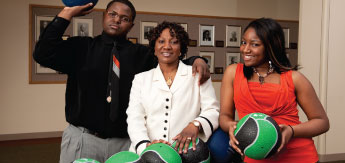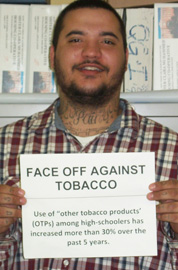Face Off Against Tobacco- BACH Launches Cutting Edge Social Media Advocacy Campaign
In an effort to reduce tobacco use, BACH tobacco coalitions and affiliated youth groups took their work to the streets of Boston and beyond, armed with cameras and statistics, in an effort to educate voters about the benefits of the Governor’s proposed increases in tobacco taxes, as well as illustrate a swell of support for its passage. In his ‘FY13 budget, Governor Patrick proposed raising the cigarette tax by 50 cents and doubling the taxes paid on other tobacco products (OTPs) to promote public health and raise revenue to fund increasing health care costs.
BACH knew this is sound public policy. Tobacco price increases are one of the most effective ways to reduce the use of tobacco products, especially among youth. With nearly 90% of smokers starting before the age of 18, raising the price of tobacco products was a critical step. Tobacco Free Massachusetts (TFM) reported that in Massachusetts alone, we spent over $4.3 Billion a year treating tobacco. And residents paid an average of $889/year in added health insurance costs to cover tobacco-related health care costs.
To ensure its passage, BACH launched its campaign, Face Off Against Tobacco. A core strategy of the campaign was the use of social media and technology to highlight tobacco issues and voter approval. Additionally, meetings with legislators provided forums for education on other tobacco products, as well as the relationship between tobacco-related illnesses and rising health care costs.
Campaign Overview and Social Media Integration
The anti-tobacco tax lobby was good at making it seem like people are against a tobacco tax. But this was not true. TFM statistics show that more than 75% of voters consistently supported increasing tobacco taxes. With Face off Against Tobacco, a picture says a thousand words and BACH’s campaign sought to take photos of hundreds of supporters. To capture both the voice and vision of BACH’s campaign, a Flickr site and Tumblr Blog were created. http://www.flickr.com/photos/bostonalliance
Almost all the groups that worked with BACH under its CPPW grant stayed to work on the campaign. Over 50 youth and a smattering of adults were trained by Nancy Marks, Tobacco Project Director and social media consultant Debra Askanese of Community 2.0, on a range of campaign related issues—from the how to’s of social media to how to speak with legislators. Participants took photos and uploaded them to a Flickr campaign site—organized by geography—to show the breadth of interest and backing.
A campaign-focused blog was also created to highlight photos and tell the story. BACH youth coalition participants (and other volunteers) chose their best photos, uploaded them onto the campaign’s blog and wrote briefly about the individual stories behind the photos. Statistics and other information were also posted. http://faceoffagainsttobacco.tumblr.com/
Once several hundred supporters were photographed, BACH youth and members shared both social media sites with the governor and legislators through email, Facebook and face-to-face meetings. In this way BACH was able to show a broad range of support (‘scale and momentum’) for raising tobacco taxes to key decision-makers.
This approach was chosen because it reinforced BACH’s goals to:
- Engage community members creatively in tobacco-related advocacy to promote dialogue with policy-makers and show concrete support for a tobacco tax
- Build bridges between and amongst BACH’s coalitions and youth groups, as well as strengthen relationships with other community organizations
- Add to the BACH coalitions’ toolbox of skills (use of social media and technology as a way to tell stories for fundraising, education, advocacy, etc.) in order to build organizational sustainability and achieve social change
- Train youth on marketable skills (social media, literacy, community engagement and advocacy) for future jobs and college application



